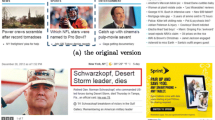Abstract
With the advance of mobile phone cameras and broadband networks, gaining access to digital information and services via logo recognition has become of high industrial interest. The fundamental subsystem for logo recognition must be a logo database, whose images link real-world information to specific corporate entities. However, few attempts have been made to create and update such a logo database, i.e., how to automatically collect the latest logos. Moreover, the few existing methods are limited in their application and unattractive in terms of logo detection accuracy and performance overhead. In this article, we describe a practical system for automatic logo extraction. Websites are an optimal source of a huge number of up-to-date logos, and experts can easily find logos from webpages without rendering. For instance, an expert can locate elements with the term “logo” using the websites’ entity names as attribute values, and then download images connected to them. Our system mimics this human behavior to automate logo extraction. Given a website, it learns its entity name and uses that name to locate elements that lead to the logo. Evaluation tests showed that this contextual reasoning significantly contributes to the performance of the system, which achieved high precision with negligible overhead.









Similar content being viewed by others
References
Azuma RT (1997) A survey of augmented reality. Teleoperators Virtual Environ 6(4):355–385
Bruns E, Brombach B, Zeidler T, Bimber O (2007) Enabling mobile phones to support large-scale museum guidance. IEEE Multimed 14(2):16–25
Baratis E, Petrakis EGM, Milios E (2008) Automatic website summarization by image content: a case study with logo and trademark images. IEEE Trans Knowl Data Eng 20(9):1195–1204
Butters J, Ciravegna F (2008) Using similarity metrics for terminology recognition. In: Proceedings of 6th international conference on language resources and evaluation (LREC’08)
Chen DM, Tsai SS, Vedantham R, Grzeszczuk R, Girod B (2009) Streaming mobile augmented reality on mobile phones. In: Proceedings of international symposium on mixed and augmented reality (ISMAR 2009), pp 181–182
Chen X, Koskela M, Hyvkk J (2010) Image based information access for mobile phones. In: Proceedings of 2010 international workshop on content-based multimedia indexing (CBMI 2010), pp 1–5
Choubassi ME, Nestares O, Wu Y, Kozintsev I, Haussecker H (2010) An augmented reality tourist guide on your mobile devices. In: Proceedings of 16th international multimedia modeling conference (MMM 2010), pp 588–602
Choubassi ME, Nestares O, Wu Y, Kozintsev I, Haussecker H (2007) A fast coarse-to-fine vehicle logo detection and recognition method. In: Proceedings of 2007 IEEE international conference on robotics and biomimetics (ROBIO 2007), pp 691–696
Hartl A, Arch C, Schmalstieg D (2011) Instant medical pill recognition on moblie phones. In: Proceedings of 16th IASTED international conference on robotics and applications (RA 2011), pp 181–188
Hesson A, Androutsos D (2008) Logo classification using haar wavelet co-occurrence histograms. In: Proceedings of IEEE canadian conference on electrical and computer engineering 2008 (CCECE08), pp 927–930
Kim JB, Jun HS (2008) Vision-based location positioning using augmented reality for indoor navigation. IEEE Trans Consum Electron 54(3):954–962
Kleban J, Xie X, Ma W (2008) Spatial pyramid mining for logo detection in natural scenes. In: Proceedings of 2008 IEEE international conference on multimedia and expo (ICME 2008), pp 1077–1080
Nieto P, Czar JR, Gonzlez-Linares JM, Guil N (2008) A tv-logo classification and learning system. In: Proceedings of 15th IEEE international conference on image processing (ICIP 2008), pp 2548–2551
Papagiannakis G, Singh G, Magnenat-Thalmann N (2008) A survey of mobile and wireless technologies for augmented reality systems. Comp Anim Virtual Worlds 19(1):2–22
Psyllos AP, Anagnostopoulos CE, Kayafas E (2010) Vehicle logo recognition using a sift-based enhanced matching scheme. IEEE Trans Intell Trans Syst 11(2):322–328
Ramachandran S (2010) Web metrics: Size and number of resources, google developers
Suh Y, Shin C, Woo W (2009) A mobile phone guide: spatial, personal, and social experience for cultural heritage. IEEE Trans Consum Electron 55(4):2356–2364
Sun S, Chen Z (2010) Robust logo recognition for mobile phone applications. J Inf Sci Eng 27(2):545–559
Takacs G, Chandrasekhar V, Gelfand N, Xiong Y, Chen W, Bismpigiannis T, Grzeszczuk R, Pulli K, Girod B (2008) Outdoors augmented reality on mobile phone using loxel-based visual feature organization. In: Proceedings of 1st ACM international conference on multimedia information retrieval (MIR08), pp 427–434
Ukkonen E (1992) Approximate string-matching with q-grams and maximal matches. Theor Comput Sci 92(1):191–211
WebSiteOptimization.com (2012) Average web page size triples since 2008, http://www.websiteoptimization.com/speed/tweak/average-web-page/
Xia L, Qi F, Zhou Q (2008) A learning-based logo recognition algorithm using sift and efficient correspondence matching. In: Proceedings of 2008 IEEE international conference on information and automation (ICIA 2008), pp 1767–1772
Acknowledgments
This work was supported by Institute for Information & communications Technology Promotion (IITP) grant funded by the Korea government (MSIP). [No. 10041145, Self-Organized Software platform (SoSp) for Welfare Devices].
Author information
Authors and Affiliations
Corresponding author
Rights and permissions
About this article
Cite this article
Jo, I., Jung, I.Y. Smart learning of logo detection for mobile phone applications. Multimed Tools Appl 75, 13211–13233 (2016). https://doi.org/10.1007/s11042-016-3293-6
Received:
Revised:
Accepted:
Published:
Issue Date:
DOI: https://doi.org/10.1007/s11042-016-3293-6




